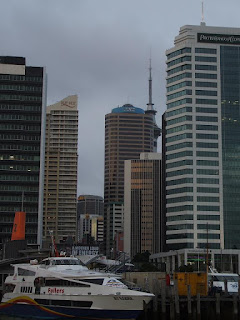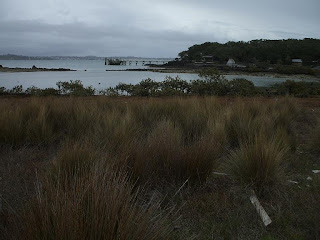The train trip took us up the East coast of the South Island, the 'mainland' as most New Zealanders (at least southislanders) call it. We passed through the plains of Canterbury, amognst the sheep and many vineyards, through the hills, and then onto the coastline south of Kaikoura. Trundling along the shore alongside the road, we would watch for the abundant fur seals dotted along the rocky shores. Some had even made their way up to the side of the road to bask in the warming rays of sun. After Kaikoura, we wove between the shore and the nearby hills. Passing over the salt lakes where ~90% of all New Zealands salt comes from, through tunnels, and into Picton where we diembarked and made our way to the ferry.
The ferry was huge. With multiple restaurants, a bar, two movie theaters (showing the most recently released screen films), and several childrens play areas, not to mention the abundant space for vehicles and people. The two-and-a-half hour trip passed quickly and before we knew it we were in Wellington.
We caught a cab into town and found our hotel tucked back into the steep

hills that delineate the city. Wellington is a very different city to Christchurch. Where Christchurch is spread over the vast plains of Canterbury and makes little use of its vast ocean shoreline, Wellington is tucked neatly into the hills that surround the town, making good use of every space available right up to the water. A very pretty city indeed. Te Papa is the national museum located in Wellington (http://www.tepapa.govt.nz/pages/default.aspx) and what a museum it is. We were told that it was the one thing not to miss while there and we were glad to have a full day to devote to exploring its vast winding halls of exhibits. There are still parts I had to leave unexplored until next time. . .
We were also able to spend some time walking around town. Along the beach drive, that took us below the ever-more cleverly built houses that protruded from the side of the ever steepening hill, the lights of the city sparkling on the dark waters of the harbour at night. Up the hill with the help of the cable car to the botanic gardens, where we saw our first keas and tui. Two essential kiwi birds.
On our third day there we packed up and head to the airport for our trip to Auckland. Flying in New Zealand is easy and relatively cheap. Especially if one is lucky and quick enough to snare a ticket from the Air New Zealand grabaseat sales they have on every Wednesday (we were not). We arrived in Auckland in the late afternoon and caught the extraordinarily expensive public transportation into town.

Stephen and I stayed at the conference hotel, while Jan stayed around the corner at a lovely hotel complete with kitchenette and clothes washer. The most obvious difference between Christchurch and Auckland is the topography. Built on a field of extinct volcanoes Auckland is not flat, nor has it allowed the steep slopes to guide it's building other than the curving of the roads. There are ~41 volcanoes within the Auckland area ranging from tiny hills that the hotel was on to enourmous volcanoe islands like Rangitoto. Fortuantely, I was able to mix in a bit of wandering during the conference and was able to join Stephen and Jan on many of their explorations.
On the second day of the conference Jan left for home and Stephen and I attended the conference dinner. What an event. Held at a local Antarctic attraction, Kelly Tarlton's Antarctic Encounter and Underwater World, the dinner was phenomenal(http://www.kellytarltons.co.nz/home/page.aspx). It began with wine and beer (yes, free) and nibbles in the aquarium. This included a large underwater passageway that took you beneath a salt-water aquarium full of ocean fish, sharks, and other sea life. After an hour we were ushered into 'Stingray Bay', which is a huge room half filled with a waist high tank holding three dinner table sized stingrays and some fish. Tables were laid out and we were invited to dig in. Several buffet tables were laid to near collapse with salads, pickles, mussles, raw oysters, steamed prawns and dozens of sauces and breads. The food was delicious and apparently only the beginning as shortly later more tables were laid out with cooked lamb, pork, chicken, fish, and pasta. After almost two hours at the tables, we waddled back onto the buses and fell into our beds at the hotel.
After the conference, Stephen and I had an extra day in Auckland and we took full advantage of it by going out to explore the volcanic island of Rangitoto. Having spent the prev

ious day there with his mom, Stephen was able to give me a tour of the parts they had visited. Of major interest to me were the tiny ferns called kidney ferns. Highly adapted to the climate, these ferns have a very small surface area meaning they reduce the amount of water loss in the long dry summer months. They also have really neat spore capsules along the outside edge of their leaf. Rangitoto is also an interesting phenomenon in that it is completely owned by the government (Department of Conservation), but there are lingering private baches (cottages) sprinkled along the shore.
That afternoon we climbed aboard the plane and made our way home. Back to Smaug and school and work. Oh well, I'm already looking forward to my next conference. . . .ACUNS in Whitehorse in early October.
